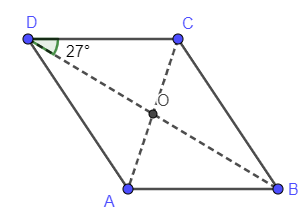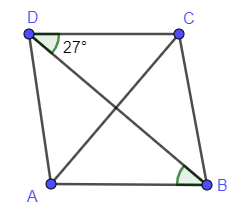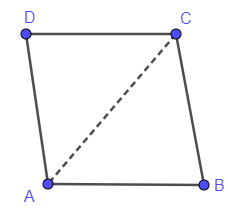
ABCD is a rhombus. Angle BDC $=27{}^\circ $ . The diagonals AC and BD cross at O. Calculate the size of angle ADC.


Answer
597.3k+ views
Hint: Firstly, apply the properties of rhombus to the angle at a given vertex. So, by that you can say the total angle made at vertex from the rule of adjacent angles are supplementary, find the angle which is required in the question.
Complete step-by-step answer:
Rule-1: Diagonals bisect each other. Thereby, bisect the angle at vertex.
Rule-1: Adjacent angles are supplementary.
Proof of diagonals bisect the angles:

By definition, we know rhombus is a parallelogram. So, we take properties of parallel lines and their corresponding angles into consideration.
By figure we can say each diagonal divides the shape into 2 triangles. So, we can use the triangles congruence properties also.
You must also take the isosceles triangle and their properties into consideration.
We prove for the diagonal AC and we take BD granted as a similar way can be used for BD.

By saying the general condition in rhombus all sides are equal, we can say:
Line segment DA is congruent to line segment AB.
Line segment CD is congruent to line segment CB.
The line segment CA is the same in both. So, it is congruent to itself.
By SSS axiom, we say triangle CAD and triangle BAC are congruent. By this we can say angles BAC and CAD are congruent.
Using this throughout question, we get
$\angle ADC=\angle ADB+\angle BDC$
$\angle BDC=\angle ADB$
By substituting value of the angle BDC, we get that:
$\angle ADC=2\cdot \angle BDC=2.27$
By simplifying the above, we get value of ADC to be:
$\angle ADC=54{}^\circ $
Therefore, the required value of the angle ADC is $54{}^\circ $.
Note: The proof of similar triangles is crucial. So, always find the corresponding sides properly or else it might lead to the wrong conclusion.
Complete step-by-step answer:
Rule-1: Diagonals bisect each other. Thereby, bisect the angle at vertex.
Rule-1: Adjacent angles are supplementary.
Proof of diagonals bisect the angles:

By definition, we know rhombus is a parallelogram. So, we take properties of parallel lines and their corresponding angles into consideration.
By figure we can say each diagonal divides the shape into 2 triangles. So, we can use the triangles congruence properties also.
You must also take the isosceles triangle and their properties into consideration.
We prove for the diagonal AC and we take BD granted as a similar way can be used for BD.

By saying the general condition in rhombus all sides are equal, we can say:
Line segment DA is congruent to line segment AB.
Line segment CD is congruent to line segment CB.
The line segment CA is the same in both. So, it is congruent to itself.
By SSS axiom, we say triangle CAD and triangle BAC are congruent. By this we can say angles BAC and CAD are congruent.
Using this throughout question, we get
$\angle ADC=\angle ADB+\angle BDC$
$\angle BDC=\angle ADB$
By substituting value of the angle BDC, we get that:
$\angle ADC=2\cdot \angle BDC=2.27$
By simplifying the above, we get value of ADC to be:
$\angle ADC=54{}^\circ $
Therefore, the required value of the angle ADC is $54{}^\circ $.
Note: The proof of similar triangles is crucial. So, always find the corresponding sides properly or else it might lead to the wrong conclusion.
Recently Updated Pages
Master Class 10 General Knowledge: Engaging Questions & Answers for Success

Master Class 10 Computer Science: Engaging Questions & Answers for Success

Master Class 10 English: Engaging Questions & Answers for Success

Master Class 10 Social Science: Engaging Questions & Answers for Success

Master Class 10 Maths: Engaging Questions & Answers for Success

Master Class 10 Science: Engaging Questions & Answers for Success

Trending doubts
The shortest day of the year in India

Why is there a time difference of about 5 hours between class 10 social science CBSE

Write a letter to the principal requesting him to grant class 10 english CBSE

What is the median of the first 10 natural numbers class 10 maths CBSE

The Equation xxx + 2 is Satisfied when x is Equal to Class 10 Maths

State and prove converse of BPT Basic Proportionality class 10 maths CBSE




